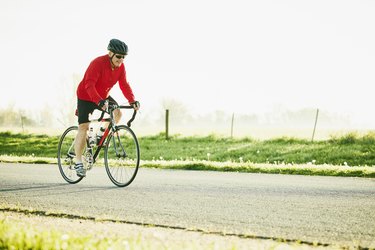
Cycling is a sport that relies on repetitive movements. Each leg rotates thousands of times during a bike ride. Because of this repetition, it's important to pay close attention to how well your bicycle fits your body. A professional bike fitting is the best way to determine if your legs are positioned at the proper angle. You also can follow many of the bike fitting guidelines to measure and adjust your bike fit at home.
Why Fit Matters
Video of the Day
Your goals help determine what kind of setup and bike fit is best. If you are a cyclist planning to race you'll desire a more aerodynamic position to generate the most power possible, while someone who rides leisurely might opt for comfort with a more upright, relaxed position on the bike. A good bike fit not only allows you to achieve comfort or tap into extra power, but it also keeps your body safe while it works in that position for hours. For instance, if your saddle is too low you might experience knee pain. A proper fit is key to avoiding injuries and poor biomechanics.
Video of the Day
Saddle Height
Start by setting the bike up in a trainer. Pedal for a few minutes and then have a friend take some measurements for you. Stop pedaling so that your foot is at the bottom of the pedal stroke. Measure the angle of your knee. It should be at 25 to 35 degrees to avoid knee issues and to achieve a powerful pedal stroke. Be sure your hips are not rocking. If they are, lower the saddle.
Saddle Position
To measure the fore-aft saddle position, pedal a few times and then stop with the cranks at the three o'clock and six o'clock position. Keep them steady as your friend drops a plumb line from your front kneecap so it's dangling down past the pedal and your shoe. In a pinch, a bolt tied to a piece of string works just as well. The plumb should hang no more than 2 cm in front of or behind your pedal spindle. Move the saddle forward or backward until you achieve this.
Considerations
These measurements are just a starting point, as no one measurement will satisfy all riders. Periodically re-check them and continue to make small adjustments. This generally means a few millimeters at a time. The body must be given time to adjust to even the smallest changes in bike fit.